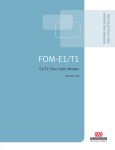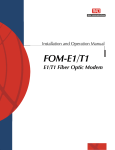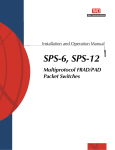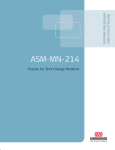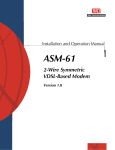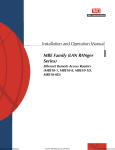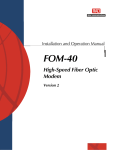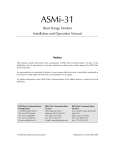Download RAD Data comm FLM-1 Specifications
Transcript
FLM-1 6/12 Port Fiber-Optic Multiplexer Installation and Operation Manual Notice This manual contains information that is proprietary to RAD Data Communications. No part of this publication may be reproduced in any form whatsoever without prior written approval by RAD Data Communications. No representation or warranties for fitness for any purpose other than what is specifically mentioned in this manual is made either by RAD Data Communications or its agents. For further information contact RAD Data Communications at the address below or contact your local distributor. International Headquarters RAD Data Communications Ltd. U.S. Headquarters RAD Data Communications Inc. 24 Raoul Wallenberg St. Tel Aviv 69719 Israel Tel: 972-3-6458181 Fax: 972-3-6498250 E-mail: [email protected] 900 Corporate Drive Mahwah, NJ 07430 USA Tel: (201) 529-1100 Toll free: 1-800-444-7234 Fax: (201) 529-5777 E-mail: [email protected] © 2001 RAD Data Communications Publication No. 303-200-02/01 Warranty This RAD product is warranted against defects in material and workmanship for a period of one year from date of shipment. During the warranty period, RAD will, at its option, either repair or replace products which prove to be defective. For warranty service or repair, this product must be returned to a service facility designated by RAD. Buyer shall prepay shipping charges to RAD and RAD shall pay shipping charges to return the product to Buyer. However, Buyer shall pay all shipping charges, duties and taxes for products returned to RAD from another country. Limitation of Warranty The foregoing warranty shall not apply to defects resulting from improper or inadequate maintenance by Buyer, Buyer-supplied firmware or interfacing, unauthorized modification or misuse, operation outside of the environmental specifications for the product, or improper site preparation or maintenance. Exclusive Remedies The remedies provided herein are the Buyer’s sole and exclusive remedies. RAD shall not be liable for any direct, indirect special, incidental, or consequential damages, whether based on contract, tort, or any legal theory. Regulatory Information FCC-15 User Information This equipment has been tested and found to comply with the limits of the Class A digital device, pursuant to Part 15 of the FCC rules. These limits are designed to provide reasonable protection against harmful interference when the equipment is operated in a commercial environment. This equipment generates, uses and can radiate radio frequency energy and, if not installed and used in accordance with the instruction manual, may cause harmful interference to the radio communications. Operation of this equipment in a residential area is likely to cause harmful interference in which case the user will be required to correct the interference at his own expense. Warning per EN 55022 This is a Class A product. In a domestic environment, this product may cause radio interference, in which case the user may be required to take adequate measures. Safety Warnings The exclamation point within a triangle is intended to warn the operator or service personnel of operation and maintenance factors relating to the product and its operating environment which could pose a safety hazard. Always observe standard safety precautions during installation, operation and maintenance of this product. Only a qualified and authorized service personnel should carry out adjustment, maintenance or repairs to this instrument. No adjustment, maintenance or repairs should be performed by either the operator or the user. Telecommunication Safety The safety status of each of the ports on the FLM-1 is declared according to EN 41003 and is detailed in the table below: Ports Safety Status DTE SELV Circuit operating with Safety Extra-Low Voltage 4W TNV-1 Circuit whose normal operating voltage does not exceed the limits of SELV, but is subject to overvoltages from Telecommunications Networks. Declaration of Conformity Manufacturer’s Name: RAD Data Communications Ltd. Manufacturer’s Address: 24 Raoul Wallenberg St. Tel Aviv 69719 Israel declares that the product: Product Name: FLM-1 Conforms to the following standard(s) or other normative document(s): EMC: EN 55022 (1994) Limits and methods of measurement of radio disturbance characteristics of information technology equipment. EN 50082-1 (1992) Electromagnetic compatibility Generic immunity standards for residential, commercial and light industry. Safety: EN 60950 (1992/93) Safety of information technology equipment, including electrical business equipment. Supplementary Information: The product herewith complies with the requirements of the EMC Directive 89/336/EEC and the Low Voltage Directive 73/23/EEC. The product was tested in a typical configuration. Tel Aviv, October 29th, 1996 Haim Karshen VP Quality European Contact: RAD Data Communications GmbH, Berner Strasse 77, 60437 Frankfurt am Main, Germany Contents CHAPTER 1 INTRODUCTION 1.1 Overview ....................................................................................................................... 1-1 General ................................................................................................................................ 1-1 Versions................................................................................................................................ 1-1 Applications.......................................................................................................................... 1-1 1.2 Physical Description ....................................................................................................... 1-3 Front Panel ........................................................................................................................... 1-4 Rear Panel ............................................................................................................................ 1-4 1.3 Functional Description ................................................................................................... 1-4 1.4 Technical Specifications ................................................................................................. 1-5 Subchannels ......................................................................................................................... 1-5 Main Channel ....................................................................................................................... 1-5 Diagnostics ........................................................................................................................... 1-6 Power................................................................................................................................... 1-7 Physical ................................................................................................................................ 1-7 Environment ......................................................................................................................... 1-7 CHAPTER 2 INSTALLATION AND SETUP 2.1 Introduction ................................................................................................................... 2-1 2.2 Site Requirements and Prerequisites .............................................................................. 2-1 2.3 Package Contents........................................................................................................... 2-1 2.4 Installation and Setup..................................................................................................... 2-2 Setting the Internal Jumpers .................................................................................................. 2-2 Connecting the Interfaces...................................................................................................... 2-3 Connecting the Subchannels ................................................................................................. 2-4 Connecting the Power........................................................................................................... 2-7 CHAPTER 3 OPERATING INSTRUCTIONS 3.1 General.......................................................................................................................... 3-1 3.2 Front Panel Indicators and Switches ............................................................................... 3-1 3.3 Operating Instructions.................................................................................................... 3-2 Power Turn-On .................................................................................................................... 3-2 Operation............................................................................................................................. 3-2 Power Turn-Off .................................................................................................................... 3-2 Operational Field Strapping Changes..................................................................................... 3-2 FLM-1 Installation and Operation Manual i Contents CHAPTER 4 TROUBLESHOOTING AND DIAGNOSTICS 4.1 Frequently Asked Question ............................................................................................ 4-1 4.2 Diagnostics Tests ............................................................................................................ 4-1 Local Loopback..................................................................................................................... 4-2 Remote Loopback................................................................................................................. 4-2 4.3 Fault Isolation and Troubleshooting ................................................................................ 4-2 APPENDIX A PIN ASSIGNMENT FOR SUBCHANNELS WITH DB-25 CONNECTORS APPENDIX B PINOUT FOR RJ-45 CONNECTORS ii FLM-1 Installation and Operation Manual List of Figures Figure 1-1 Typical Point-to-Point Application................................................................................ 1-2 Figure 1-2 Typical Ring Installation ............................................................................................... 1-2 Figure 1-3 FLM-1 3D View ........................................................................................................... 1-3 Figure 2-1 Strapping Diagram ....................................................................................................... 2-3 Figure 2-2 FLM-1/4W Rear Panel with a Terminal Block Main Link Connector ............................. 2-3 Figure 2-3 FLM-1/4W Rear Panel with an RJ-45 Main Link Connector.......................................... 2-3 Figure 2-4 FLM-1/DF Rear Panel with a DF Main Link Connector................................................. 2-3 Figure 2-5 FLM-1/4W Rear Panel with RJ-45 Main Link and Subchannel Connectors ................... 2-4 Figure 2-6 FLM-1/DF Rear Panel with STA Main Link and RJ-45 Subchannel Connectors ............ 2-4 Figure 2-7 FLM-1/4W Rear Panel with Main Link Terminal Block and RJ-45 Subchannel Connectors ............................................................................................................................. 2-4 Figure 2-8 Connecting Channel Doubler to an FLM-1 Subchannel for 12 Channel Operation....... 2-5 Figure 2-9 Suggested Connection for Transmitting DTR to DSR Control Signals End-to-End (DB-25 Connectors) ................................................................................................................ 2-5 Figure 2-10 Suggested Connection for Transmitting RTS to DCD Control Signals End-to-end (DB-25 Connectors) ................................................................................................................ 2-5 Figure 2-11 Suggested Connection for Transmitting DTR to DSR Control Signals End-to-End (RJ-45 Connectors).................................................................................................................. 2-6 Figure 2-12 Suggested Connection for Transmitting RTS to DCD Control Signals End-to-end (RJ-45 Connectors).................................................................................................................. 2-6 Figure 3-1 FLM-1 Front Panel ....................................................................................................... 3-1 List of Tables Table 1-1 Distortion and Number of Sites for FLM-1 in Ring Application ....................................... 1-3 Table 1-2 Performance in Various Modes of Operation ................................................................. 1-4 Table 3-1 FLM-1 Indicators and Switches ...................................................................................... 3-2 Table 4-1 Fault Isolation and Troubleshooting................................................................................ 4-3 FLM-1 Installation and Operation Manual iii List of Tables iv FLM-1 Installation and Operation Manual Chapter 1 Introduction 1.1 Overview General FLM-1 is a full duplex time division asynchronous multiplexer enabling up to twelve async terminals to be multiplexed onto a single channel. FLM-1 is intended for use in manufacturing facilities, building complexes, campuses and other similar point-to-point and ring applications. Versions One of the following media options for the main channel interface is available with the unit: • Electrical option (FLM-1/4W): 4-wire for transmission over two twisted pairs (terminal block or RJ-45 connector) • Optical option (FLM-1/DF): Dual fiber for transmission over dual fiber-optic cable. Secondary channels are represented by six DB-25 connectors or 12 RJ-45 connectors. For detailed information about main and secondary channel options see Section 1-4, “Technical Specifications” and Connecting the Interfaces in Section 2-5. Applications Point-to-Point Application FLM-1 is used mainly for point-to-point configurations where distances of up to several kilometers are involved. Figure 1-1 shows a typical application where a cluster of terminals is connected to a host computer through a single link. Maximum data rate on each FLM-1 subchannel is 19.2 kbps for the 4-wire version and 38.4 kbps for the dual-fiber version, with 12.5% distortion when working with 6 data channels and 25% distortion when working with 12 data channels or 6 data + 6 control channels. 16/01/01 11:12 AM Overview 1-1 FLM-1 Installation & Operation Manual Chapter 1 - Introduction Figure 1-1 Typical Point-to-Point Application Ring Application For installations involving clusters of terminals distributed in several locations, FLM-1 units may be installed in a ring-type configuration, as shown in Figure 1-2. 4 TERM T 1 2-WIRE FLM-1 HOST 12 1 R 4 FLM-1 R T 2-WIRE 2-WIRE T 4 TERM 4 TERM R 9 12 FLM-1 2-WIRE FLM-1 5 8 R T Figure 1-2 Typical Ring Installation Note 1-2 Overview In this application, the unconnected channels at each site must be bypassed by shorting Pins 2 and 3 of the relevant subchannel connector. 16/01/01 11:12 AM FLM-1 Installation & Operation Manual Chapter 1 - Introduction Table 1-1 shows distortion per node and maximum number of nodes/sites allowed for different data rates on each subchannel, for the 4-wire and the dual-fiber versions. Table 1-1 Distortion and Number of Sites for FLM-1 in Ring Application Data Rate (kbps) Distortion per Node (%) Number of Nodes/Sites 4 wire Fiber 4 wire Fiber 19.2 25.00 12.50 2 4 9.6 12.50 6.250 3 4 4.8 6.250 3.125 4 8 2.4 3.125 1.5625 8 16 1.2 1.5625 0.78125 16 32 1.2 Physical Description A 3D view of FLM-1 is shown in Figure 1-3. Figure 1-3 FLM-1 3D View 16/01/01 11:12 AM Physical Description 1-3 FLM-1 Installation & Operation Manual Chapter 1 - Introduction Front Panel The front panel provides control over the operation of the unit. The LEDs provide real-time indications related to the operation and status of the unit. Two push-button switches allow test loopbacks for the FLM-1 diagnostics. For details, see Chapter 3, “Operation” and Chapter 4, “Troubleshooting and Diagnostics”. Rear Panel The rear panel of the unit allows access to interface and power connections. For details, see Chapter 2, “Installation”. 1.3 Functional Description FLM-1 can operate in two operation modes: set to 6 or 12 channels, which is controlled by a user-selectable strap. When the unit is set for six channels, each channel can be used to transmit full duplex data end-to-end. When the unit is set for twelve channels, each subchannel can be used for either data or control signal transmission, according to the specific application. For example: • Note In the case of DB-25 connectors version, this mode requires a channel doubler cable (see Section 2.4 for details). • Note All twelve channels can be used to transmit full duplex data end-to-end. Six channels can be used to transmit full duplex data and six can be used to transmit control signals end-to-end. This operation mode requires a channel doubler of another type. This channel double would be different for different types of subchannel connectors (DB-25 or RJ-45) and different types of control signal. For more information see Connecting the Interface in Section 2-5. Multiplexing is implemented by using an over-sampling technique. Each of the twelve channels is sampled at 78.6 kbps for the electrical (4-wire) option or at 157.2 kbps for the optical (fiber) option. Table 1-2 summarizes the FLM-1 performance with various options and modes of operation. Table 1-2 Performance in Various Modes of Operation 1-4 No. of Max Subchannels in Use Data Rate (kbps) 4 Wire Fiber 6 19.2 12.5 6.25 6 38.4 - 12.5 12 19.2 25.0 12.5 12 38.4 - 25.0 Functional Description Distortion (%) 16/01/01 11:12 AM FLM-1 Installation & Operation Manual Note Chapter 1 - Introduction 1. The distortion refers to the duty cycle and not to the voltage level. 2. Whenever possible (if the number of channels is less than or equal to 6) it is recommended to operate FLM-1 in the six-channel mode, which results in less distortion. 1.4 Technical Specifications Subchannels Transmission format Asynchronous Data rate Optical interface: up to 38.4 kbps Electrical interface: up to 19.2 kbps Main Channel 16/01/01 11:12 AM Distortion See Table 1-2 Interface RS-232/V.24 Number of subchannels Up to six or up to twelve, depending on the version and availability of a channel doubler (see Section 2.4) Connectors Six D-type 25-pin, female, or twelve RJ-45 Mode of operation Full-duplex Electrical Interface Transmission line 4-wire unconditioned telephone lines (two twisted pairs) Operating range Maximum of 1.6 km (1 mile) on 22 AWG cable Data rate 1.2288 Mbps Output format Balanced, transformer isolated, 6V peak-to-peak (on 100Ω) Input resistance 100Ω Connector Terminal block or RJ-45 Technical Specifications 1-5 FLM-1 Installation & Operation Manual Chapter 1 - Introduction Optical Interface Transmission line Double optical cable Operating range for 850 nm: up to 5 km (3.1 miles) for 1300 nm: up to 40 km (25 miles) with attenuation of of 0.5 dB/km with 9/125µ fiber optic cable Data rate 2.4576 Mbps Operating wavelength 850 nm or 1300 nm Optical output level Diagnostics Switches and Indicators 1-6 for 850 nm: -24 dBm min into 50/125 fiber -20 dBm min into 62.5/125 fiber for 1300 nm: -18 dBm min into 9/125 fiber Receiver sensitivity -40 dBm min Dynamic range 24 dB Connectors Standard SMA or ST connectors In compliance with ITU V.54 Local digital loopback Activated by the LLB push button Remote digital loopback Activated by the RLB push button POWER LED (Green) ON when the unit is powered TEST LED (Yellow) ON when the local or remote unit is performing a loopback LOCAL SYNC LOSS LED (Red) ON when synchronization is lost at the local unit REMOTE SYNC LOSS LED (Red) ON when synchronization is lost at the remote unit LLB Switch When pressed, the unit is performing local loopback RLB Switch When pressed, the unit is performing remote loopback Technical Specifications 16/01/01 11:12 AM FLM-1 Installation & Operation Manual Chapter 1 - Introduction Power 100/115/230 VAC (± 10%), 50-60 Hz, 7.5 VA Max Physical Height 4.4 cm / 1.72 in (1U) Width 33.8 cm / 13.30 in Depth 22.0 cm / 8.60 in Weight 1.6 kg / 3.50 lb Temperature Humidity 0-50°C / 32-122°F Up to 90%, non-condensing Environment 16/01/01 11:12 AM Technical Specifications 1-7 Chapter 1 - Introduction 1-8 Technical Specifications FLM-1 Installation & Operation Manual 16/01/01 11:12 AM Chapter 2 Installation and Setup 2.1 Introduction This chapter provides instructions for mechanical and electrical installation of FLM-1. Sections 2.2 and 2.3 describe site preparation for installation of FLM-1. Section 2.4 describes mechanical and electrical installation, including strap selection, setting the internal jumpers, connecting the main link and subchannel interfaces and connecting the power. After completing installation, refer to Chapter 3 for operating information and system checkout to ensure proper operation. 2.2 Site Requirements and Prerequisites Install FLM-1 within 1.5m (5 ft) of an easily accessible grounded AC outlet. The outlet should be capable of furnishing the voltage in accordance with the rated voltage of the unit. Allow at least 90 cm (36 in) of frontal clearance for operating and maintenance accessibility. Allow at least 10 cm (4 in) clearance at the rear of the unit for signal lines and interface cables. 2.3 Package Contents The FLM-1 package includes the following items: 16/01/01 11:12 AM • The FLM-1 unit • The FLM-1 Installation and Operation Manual • The AC power cord. Package Contents 2-1 Chapter 2 - Installation and Setup FLM-1 Installation & Operation Manual 2.4 Installation and Setup The FLM-1 units are delivered completely assembled. The units are designed for desktop installation or mounting in a 19-inch rack. Installation procedures for the FLM-1 unit are provided in the following paragraphs. For rack installation of FLM-1, refer to the Rack Mounting Kit for 19-inch Racks guide that comes with the RM kit. To complete the installation of FLM-1, you must perform the following (in the given order): Setting the Internal Jumpers • Determine the required configuration of FLM-1, according to your application, and set the internal jumpers accordingly. • Connect the subchannel and main link interfaces. • Connect power to the unit. Before connecting the interfaces and power to the unit, determine the required configuration of FLM-1 and position the straps accordingly. To do this, proceed as follows: Access to the inside of the equipment is permitted only to authorized and qualified service personnel. Warning To avoid accidental electric shock, always disconnect the power cord before removing the unit from its casing. 1. Unscrew the upper cover screw located at the back of the unit. 2. Slide the rear drawer out. 3. Locate the strap marked “SELECT 6 OR 12 CHANNELS” on the circuit board. For up to 6 channels with no control applications, place the strap to 6. For any other application, place the strap to 12 (see Figure 2-1). 4. Locate the strap marked GND. According to your requirements, set the signal ground to be connected to shielding (chassis) ground or floating (NC). The factory setting is GND connected to Chassis ground. This setting is strongly recommended unless it is absolutely necessary to do otherwise. 5. Slide the rear drawer back to its place. 6. Fasten the upper cover screw at the back of the unit. Caution 2-2 The safety status of the 4W port is TNV-1, operating within the limits of SELV. If the 4W network does not fulfill this requirement, the signal ground must be connected to the chassis ground. Installation and Setup 16/01/01 11:12 AM FLM-1 Installation & Operation Manual Chapter 2 - Installation and Setup GND 32 NC 12 SELECT 6 OR 12 6 CHANNELS J1 Figure 2-1 Strapping Diagram Connecting the Interfaces Figure 2-2 to Figure 2-7 show the FLM-1 rear panel in all its versions, containing different main link and subchannel connectors. Figure 2-2 to Figure 2-4 show the FLM-1 versions with DB-25 subchannel connectors and different main link connectors: terminal block, RJ-45, and dual fiber. Figure 2-5 to Figure 2-7 show the FLM-1 versions with RJ-45 subchannel connectors and different main link connectors: terminal block, RJ-45, and dual fiber. MAIN CHANNEL RX-B RX-A TX-B TX-A 115 VAC 0.2A T 250V CH 1/7 CH 2/8 CH 3/9 CH 4/10 CH 5/11 CH 6/12 Figure 2-2 FLM-1/4W Rear Panel with a Terminal Block Main Link Connector MAIN CHANNEL 115 VAC 0.2A T 250V CH 1/7 CH 2/8 CH 3/9 CH 4/10 CH 5/11 CH 6/12 Figure 2-3 FLM-1/4W Rear Panel with an RJ-45 Main Link Connector MAIN CHANNEL 115 VAC 0.2A T 250V RX CH 1/7 CH 2/8 CH 3/9 CH 4/10 CH 5/11 CH 6/12 TX Figure 2-4 FLM-1/DF Rear Panel with a DF Main Link Connector 16/01/01 11:12 AM Installation and Setup 2-3 FLM-1 Installation & Operation Manual Chapter 2 - Installation and Setup MAIN SUBCHANNELS CHANNEL 1 2 3 4 5 6 7 8 9 10 11 12 115 VAC 0.2A T 250V Figure 2-5 FLM-1/4W Rear Panel with RJ-45 Main Link and Subchannel Connectors MAIN CHANNEL SUBCHANNELS 1 2 3 4 5 6 7 8 9 10 11 12 115 VAC 0.2A T 250V RX TX Figure 2-6 FLM-1/DF Rear Panel with STA Main Link and RJ-45 Subchannel Connectors MAIN CHANNEL RX-B RX-A SUBCHANNELS TX-B TX-A 1 115 VAC 0.2A T 250V 2 3 4 5 6 7 8 9 10 11 12 Figure 2-7 FLM-1/4W Rear Panel with Main Link Terminal Block and RJ-45 Subchannel Connectors Connecting the Subchannels DB-25 Connectors In this version, six D-type 25-pin female connectors on the rear panel (see Figures 2-2 to 2-4) enable connection to the unit. Detailed information about the signals present at these connectors is given in Appendix A. To have FLM-1 operating in a 6-channel mode, use standard cables with DB-25 male connectors. To have FLM-1 operating in a 12-channel mode, use channel doubler cables (CD). You can order these cables from RAD or make them yourself according to pinout shown in Figure 2-8 below. To have FLM-1 operating in a 6-channel operation with full duplex data and control signals transmitted end-to-end, you have to make special cables (not provided by RAD). Figure 2-9 shows suggested pin connections for transmitting a DTR-to-DSR control signal and Figure 2-10 those for transmitting an RTS-to-DCD control signal. 2-4 Installation and Setup 16/01/01 11:12 AM FLM-1 Installation & Operation Manual Chapter 2 - Installation and Setup FLM-1 Subchannel Connector Channel Doubler Cable Port A 1 2 3 4 5 6 8 15 17 20 24 7 Protective Ground Transmitted Data (TD) Received Data (RD) Request to Send (RTS) Clear to Send (CTS) Data Set Ready (DSR) Received Line Signal Detector Not Used Signal Ground 1 2 3 4 5 6 8 15 17 20 24 7 1 2 3 4 5 6 8 15 17 20 24 7 Port B 14 16 19 13 21 12 11 18 25 23 Secondary TD Secondary RD Secondary RTS Secondary CTS Secondary DSR Secondary RLSD Not Used 1 2 3 4 5 6 8 15 17 20 24 7 14 16 19 13 21 12 11 18 25 23 Figure 2-8 Connecting Channel Doubler to an FLM-1 Subchannel for 12 Channel Operation FLM-1 Subchannel Connector Protective Ground Transmitted Data (TD) Received Data (RD) Request to Send (RTS) Clear to Send (CTS) Data Set ready (DSR) Received Line Signal Detector Signal Ground Secondary TD Secondary RD 1 2 3 4 5 6 8 7 14 16 Channel Data and Control Connection 1 2 3 4 5 6 7 8 14 16 Special Cable 1 (DB-25) 1 2 3 4 5 6 7 8 20 Figure 2-9 Suggested Connection for Transmitting DTR to DSR Control Signals End-to-End (DB-25 Connectors) FLM-1 Subchannel Connector Protective Ground Transmitted Data (TD) Received Data (RD) Request to Send (RTS) Clear to Send (CTS) Data Set ready (DSR) Received Line Signal Detector Signal Ground Secondary TD Secondary RD 1 2 3 4 5 6 8 7 14 16 Channel Data and Special Cable 2 (DB-25) Control Connection 1 2 3 4 5 6 8 7 14 16 1 2 3 4 5 6 7 8 Figure 2-10 Suggested Connection for Transmitting RTS to DCD Control Signals End-to-end (DB-25 Connectors) 16/01/01 11:12 AM Installation and Setup 2-5 FLM-1 Installation & Operation Manual Chapter 2 - Installation and Setup RJ-45 Connectors Twelve RJ-45 modular jacks on the rear panel (see Figures 2-5 to 2-7) each support a single channel. Pinout for this option is given in Appendix B. The six-channel operation with full duplex data and transmitting control signals end-to-end requires special cables (not provided by RAD). Figure 2-11 shows suggested pin connections for transmitting a DTR-to-DSR control signal and Figure 2-12 those for transmitting an RTS-to-DCD control signal. FLM-1 Subchannel Connector Channels 1-6 Channels 7-12 Protective Ground Transmitted Data (TD) Received Data (RD) Request to Send (RTS) Clear to Send (CTS) Data Set ready (DSR) Received Line Signal Detector Signal Ground Secondary TD Secondary RD Channel Data and Control Connection 1 5 3 2 8 6 4 7 1 5 3 2 8 6 4 7 5 3 n/c n/c n/c n/c n/c n/c 5 3 n/c n/c n/c n/c n/c n/c Special Cable 1 (DB-25) 1 2 3 4 5 6 8 20 7 Figure 2-11 Suggested Connection for Transmitting DTR to DSR Control Signals End-to-End (RJ-45 Connectors) FLM-1 Subchannel Connector Channels 1-6 Channels 7-12 Protective Ground Transmitted Data (TD) Received Data (RD) Request to Send (RTS) Clear to Send (CTS) Data Set ready (DSR) Received Line Signal Detector Signal Ground Secondary TD Secondary RD Channel Data and Control Connection 1 5 3 2 8 6 4 7 1 5 3 2 8 6 4 7 5 3 n/c n/c n/c n/c n/c n/c 5 3 n/c n/c n/c n/c n/c n/c Special Cable 2 (DB-25) 1 2 3 4 5 6 7 8 Figure 2-12 Suggested Connection for Transmitting RTS to DCD Control Signals End-to-end (RJ-45 Connectors) 2-6 Installation and Setup 16/01/01 11:12 AM FLM-1 Installation & Operation Manual Chapter 2 - Installation and Setup Connecting the Main Channel 4-wire Version - Terminal Block A 5-screw terminal block is located at the rear panel (see Figures 2-2 and 2-7). Five wires, marked TX-A, TX-B, RX-A, RX-B and CHASSIS GND connect transmit and receive wires and the cable shield (if available). To connect the main link with the terminal block, proceed as follows: 1. Connect TX connectors at the local unit to RX connectors at the opposite unit. 2. Connect RX connectors at the local unit to TX connectors at the opposite unit. 3. Connect the ground wires, if necessary. 4-Wire Version - RJ-45 Jack Pinout for this version is given in Appendix B. Dual-Fiber Version Two SMA or ST connectors, marked TX and RX, are located on the rear panel. To connect the interface, proceed as follows: 1. Remove the protective caps from the connectors and keep them in a safe place for later use. 2. Clean both connectors to remove dust accumulated during shipment (using ethanol or a similar cleaning fluid). 3. Connect the transmit fiber to the TX connector and the receive fiber to the RX connector, and secure the fastening nuts. At the remote unit, the transmit fiber must be connected to RX and the receive fiber to TX. Caution Connecting the Power 16/01/01 11:12 AM Do not overtighten the fiber-optic connectors. AC power is supplied to the FLM-1 through a 1.5 m (5 ft) cord terminated by a grounded 3-wire plug. The AC cord is fused at the rear panel AC power receptacle of the unit. A slow-blow fuse of 0.1A is required for 230 VAC operation, and a slow-blow 0.2A fuse for 115 VAC operation. Installation and Setup 2-7 Chapter 2 - Installation and Setup Warning FLM-1 Installation & Operation Manual Before connecting power to the unit, verify that the socket outlet is provided with a protective earth contact. If you are using an extension cord (power cable) make sure it is grounded as well. Interrupting the protective (grounding) conductor (inside or outside the unit), or disconnecting the protective earth terminal can make this unit dangerous. Make sure that only fuses of the required rating, as marked on the rear panel, are used for replacement. Do not use repaired fuses or short-circuit the fuse holder. Always disconnect the mains cable before removing or replacing the fuse. Whenever it is likely that the fuse protection has been damaged, make the unit inoperative. To connect power to FLM-1, simply insert its power cord into the power socket. 2-8 Installation and Setup 16/01/01 11:12 AM Chapter 3 Operating Instructions 3.1 General This chapter covers: • A list of controls and indicators together with their functions. • An operating procedure covering power turn-on, operating instructions, and power turn-off. • Information on strapping. Before operating FLM-1, complete all the installation procedures described in Chapter 2. 3.2 Front Panel Indicators and Switches The FLM-1 front panel is shown in Figure 3-1. SYNC LOSS POWER TEST LOCAL REMOTE LLB RLB Figure 3-1 FLM-1 Front Panel 09/01/01 4:29 PM Front Panel Indicators and Switches 3-1 FLM-1 Installation & Operation Manual Chapter 3 - Operation Table 3-1 lists the functions of the FLM-1 indicators and switches. Table 3-1 FLM-1 Indicators and Switches Identification No Name Type Function 1 POWER LED Indicator (green) Lights up when the unit is powered. 2 TEST LED Indicator (yellow) Lights up when either local or remote unit is performing a loopback test. 3 SYNC LOSS LOCAL LED Indicator (red) Lights up when synchronization is lost at the local unit. 4 SYNC LOSS REMOTE LED Indicator (red) Lights up when synchronization is lost at the remote unit. 5 LLB Push button When pressed (pushed in), the unit performs a local loopback. 6 RLB Push button When pressed (pushed in), the unit performs a remote loopback. Note Pressing LLB and RLB simultaneously has no effect; the unit just continues to operate normally. 3.3 Operating Instructions Power Turn-On To apply AC power to FLM-1, connect its power cord to an acceptable AC source. The POWER LED should light up. If the local and remote FLM-1 units are in operation and properly connected via the main channel, no other indicator should be ON. If it is not so, refer to Chapter 4 for troubleshooting information. Operation FLM-1 operates entirely unattended except when performing system tests. Power Turn-Off To turn off FLM-1, simply remove the AC power cord from the AC source. Operational Field If it becomes necessary to reconfigure FLM-1 for twelve-channel mode or six-channel mode operation, follow the appropriate setup procedure Strapping described in Section 2.4. Changes Access to the inside of the equipment is permitted only to authorized and qualified service personnel. Warning 3-2 Operating Instructions 09/01/01 4:29 PM Chapter 4 Troubleshooting and Diagnostics 4.1 Frequently Asked Question Question: How can I connect six pairs of DTEs for transferring Data and Control Signals (RTS to DCD) end-to-end? Answer: First set the jumper marked “SELECT 6 OR 12 CHANNELS” to the “12” position. Now FLM-1 passes 12 pairs of signals (TD and RD of channels 1 to 6 and secondary TD and RD of channels 7 to 12) end-to-end. All the other channel signals are local: they do not pass end-to-end, being transmitted between FLM-1 and the DTE (see Table B-2). To transfer the control signals end-to-end, you must make a special cable. If you have a model with DB-25 subchannel connectors, for exact wiring see Figure 2-10; if your model has RJ-45 subchannel connectors, see Figure 2-12. This way you are using channel 1 to pass the data signals end to-end, and channel 7 (secondary channel) to pass the RTS and DCD signals end-to-end. 4.2 Diagnostics Tests FLM-1 features ITU V.54 diagnostic capabilities for performing loopback tests. FLM-1 supports two types of loopback tests: a local loopback and remote loopback. Note 09/01/01 4:29 PM Before you start to perform any of the loopback tests, set to OFF (negative voltage) the following signals at the remote unit subchannels: - Received Data (Circuit 104) - Clear to Send (Circuit 106) - Receive Line Signal Detector (Circuit 109) Diagnostics Tests 4-1 Chapter 4 - Troubleshooting and Diagnostics Local Loopback FLM-1 Installation & Operation Manual When FLM-1 performs a local loopback, the data from the local transmitter is looped back to the local receiver at the digital level, thus checking all local digital circuitry for proper operation. To activate the test, press the LLB push button located on the front panel. If the local unit is operating properly, the yellow TEST indicator should light up and all other indicators should be OFF. If the local and remote units are properly connected via the main channel, this test also checks the following: • Local transmitter analog interface • Remote analog section • Digital receiver section. In this case the yellow TEST indicator on the remote unit should also be lit up. Remote Loopback The remote loopback loops back data from the remote receiver to the remote transmitter, thus checking: • • • • All local digital circuitry Both local and remote analog interfaces Main channel link Remote digital receiver section. To activate the test, press the RLB push button on the front panel. If both local and remote units operate properly, the yellow TEST indicators should be lit at both units and all other indicators should be OFF. 4.3 Fault Isolation and Troubleshooting The symptoms and corresponding procedures listed in Table 4-1 will help you identify, isolate, and correct faults in accordance with the tools available. Warning 4-2 These service instructions are for use by qualified personnel only. To avoid electric shock, do not perform any servicing other than that contained in the operating instructions unless you are qualified to do so. Fault Isolation and Troubleshooting 09/01/01 4:29 PM FLM-1 Installation & Operation Manual Chapter 4 - Troubleshooting and Diagnostics Table 4-1 Fault Isolation and Troubleshooting Symptom All front panel indicators are OFF Action 1. Check that power is supplied to the unit. 2. Check the fuse inside the AC receptacle on the rear panel and replace it with a new one. 3. Replace the unit. The fault is probably in the unit's power supply circuits. LOCAL SYNC LOSS LED is ON 1. Perform an LLB test as described in Section 4-1. The yellow TEST LED should light and LOCAL SYNC LOSS should go OFF. If this does not happen, replace the local unit. Otherwise proceed to step 2. 2. Perform an RLB test. The yellow TEST LED should light and LOCAL SYNC LOSS should go OFF. If this does not happen, replace the local unit. Otherwise proceed to step 3. 3. Perform steps 1 and 2 at the remote site. If the fault is still not located, replace both units one at a time. If the problem persists, the main channel link between the units is probably defective and should be checked. REMOTE SYNC LOSS LED is ON 4. Perform an LLB test at the remote unit. The yellow TEST LED should light and LOCAL SYNC LOSS should go OFF. If this does not happen, replace the remote unit. Otherwise proceed to step 2. 5. Perform an RLB test at the remote unit. The yellow TEST LED should light and LOCAL SYNC LOSS should go OFF. If this does not happen, replace the remote unit. Otherwise proceed to step 3. 6. Perform steps 1 and 2 at the local site. If the fault is still not located, replace both units one at a time. If the problem persists, the main channel link between the units is probably defective and should be checked. 09/01/01 4:29 PM Fault Isolation and Troubleshooting 4-3 Chapter 4 - Troubleshooting and Diagnostics 4-4 Fault Isolation and Troubleshooting FLM-1 Installation & Operation Manual 09/01/01 4:29 PM Appendix A Pin Assignment for Subchannels with DB-25 Connectors Table A-1 Pin Assignment for Subchannels with DB-25 Connectors V.24 RS-232 Pin Signal Description 101 AA 1 Protective Ground Chassis ground. May be isolated from signal ground (see Section 2-4). 102 AB 7 Signal Ground Common signal and DC power supply ground. 103 BA 2 (14) TD - Transmit Data Serial digital data into FLM-1, end-to-end. 104 BB 3 (16) RD - Receive Data Serial digital data output from FLM-1, end-to-end. 105 CA 4 (19) RTS - Request To Send A positive level to FLM-1 when data transmission is desired, shorted to CTS. 106 CB 5 (13) CTS - Clear To Send A positive level from FLM-1 (if data transmission is possible), shorted to RTS. 107 CC 6 (21) DSR - Data Set Ready A positive DC voltage (+8V) from FLM-1 indicating that the unit is powered. 109 CF 8 (12) DCD - Receive Line Signal Detector (Carrier Detect) A positive level from FLM-1 except when either a sync loss occurs or remote loopback is performed. − − 9 This signal (+8V) is reserved for data set testing and for powering miniature modems 10 This signal (-8V) is reserved for data set testing and for powering miniature modems Note 09/01/01 4:29 PM Pin numbers in parentheses are for the secondary channel, available when using a channel doubler cable (working in 12-channel operation mode). A-1 Appendix A - Pin Assignment for Subchannels with DB-25 Connectors A-2 FLM-1 Installation & Operation Manual 09/01/01 4:29 PM Appendix B Pinout for RJ-45 Connectors The pinouts of the RJ-45 connectors for the FLM-1 line (main channel) and subchannels are given in Tables B-1 and B-2, respectively. Table B-1 Pin Signal 1 RX 2 RX 3 NC 4 NC 5 NC 6 NC 7 TX 8 TX Table B-2 Pin Main Channel Pinout Signal Subchannel Pinout Note 1 V+ 2 RTS Shorted to CTS 3 RXD End-to-end, from FLM-1 4 DCD According to main link sync status 5 TXD End-to-end, into FLM-1 6 DSR Always +8V 7 Signal GND 8 CTS Shorted to RTS B-1 Appendix B - Pinout for RJ-45 Connectors B-2 FLM-1 Installation & Operation Manual


































